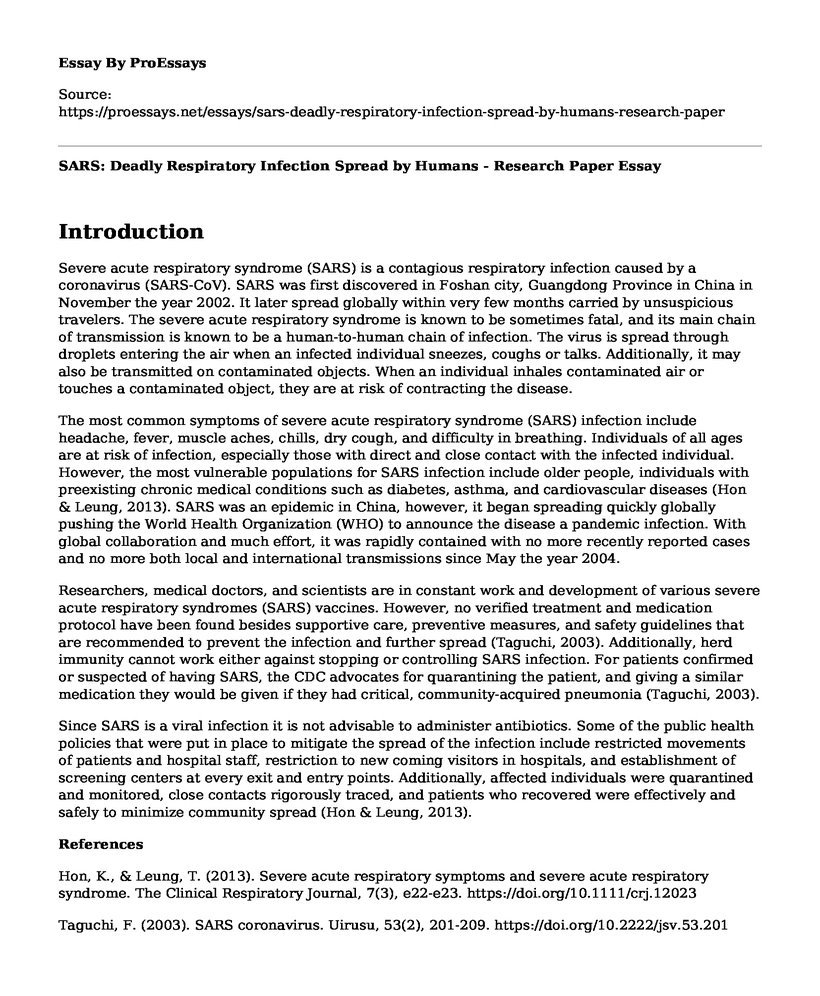Introduction
Severe acute respiratory syndrome (SARS) is a contagious respiratory infection caused by a coronavirus (SARS-CoV). SARS was first discovered in Foshan city, Guangdong Province in China in November the year 2002. It later spread globally within very few months carried by unsuspicious travelers. The severe acute respiratory syndrome is known to be sometimes fatal, and its main chain of transmission is known to be a human-to-human chain of infection. The virus is spread through droplets entering the air when an infected individual sneezes, coughs or talks. Additionally, it may also be transmitted on contaminated objects. When an individual inhales contaminated air or touches a contaminated object, they are at risk of contracting the disease.
The most common symptoms of severe acute respiratory syndrome (SARS) infection include headache, fever, muscle aches, chills, dry cough, and difficulty in breathing. Individuals of all ages are at risk of infection, especially those with direct and close contact with the infected individual. However, the most vulnerable populations for SARS infection include older people, individuals with preexisting chronic medical conditions such as diabetes, asthma, and cardiovascular diseases (Hon & Leung, 2013). SARS was an epidemic in China, however, it began spreading quickly globally pushing the World Health Organization (WHO) to announce the disease a pandemic infection. With global collaboration and much effort, it was rapidly contained with no more recently reported cases and no more both local and international transmissions since May the year 2004.
Researchers, medical doctors, and scientists are in constant work and development of various severe acute respiratory syndromes (SARS) vaccines. However, no verified treatment and medication protocol have been found besides supportive care, preventive measures, and safety guidelines that are recommended to prevent the infection and further spread (Taguchi, 2003). Additionally, herd immunity cannot work either against stopping or controlling SARS infection. For patients confirmed or suspected of having SARS, the CDC advocates for quarantining the patient, and giving a similar medication they would be given if they had critical, community-acquired pneumonia (Taguchi, 2003).
Since SARS is a viral infection it is not advisable to administer antibiotics. Some of the public health policies that were put in place to mitigate the spread of the infection include restricted movements of patients and hospital staff, restriction to new coming visitors in hospitals, and establishment of screening centers at every exit and entry points. Additionally, affected individuals were quarantined and monitored, close contacts rigorously traced, and patients who recovered were effectively and safely to minimize community spread (Hon & Leung, 2013).
References
Hon, K., & Leung, T. (2013). Severe acute respiratory symptoms and severe acute respiratory syndrome. The Clinical Respiratory Journal, 7(3), e22-e23. https://doi.org/10.1111/crj.12023
Taguchi, F. (2003). SARS coronavirus. Uirusu, 53(2), 201-209. https://doi.org/10.2222/jsv.53.201
Cite this page
SARS: Deadly Respiratory Infection Spread by Humans - Research Paper. (2023, May 14). Retrieved from https://proessays.net/essays/sars-deadly-respiratory-infection-spread-by-humans-research-paper
If you are the original author of this essay and no longer wish to have it published on the ProEssays website, please click below to request its removal:
- The Concept of Pain in Nursing - Paper Example
- Essay Sample on Gastric Surgery: A Conventional Approach for Weight-Loss
- Essay Example on Vaccines: Boosting Immunity and Creating Adaptive Immunity
- Essay Example on COVID-19: One Million Infected in Under Three Months
- Health Care Reimbursement: Retrospective & Prospective Strategies - Essay Sample
- Essay Example on Board of Education: Eradicating Infectious Diseases & Limiting Spread in Schools
- 16yo Girl Experiences Anxiety, Fear, Excessive Guilt, Sleepiness, Eating Changes - Free Essay







